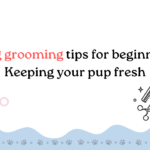The Best Fluffy Pancakes recipe you will fall in love with. Full of tips and tricks to help you make the best pancakes.
Why should you potty train your dog?
Step 1: Set up a potty area
Step 2: Establish a Routine
Take your dog to the chosen spot at fixed times each day. Key moments include:
- Right after waking up
- After meals
- After playtime
- Before bedtime
Puppies, in particular, need to be taken out frequently, about every 1 – 2 hours, because their bladders are small, they can’t hold it for long. Adult dogs can wait longer but still need a consistent schedule. With regular practice, your dog will understand that this is potty time.
Step 3: Praise Consistently
Step 4: Watch for Signs
Step 5: Handle Accidents Calmly
Step 6: Try Crate Training
Tips for successful puppy potty training
- Be Patient: Every dog learns at their own pace. Puppies might take weeks, while older dogs with bad habits could need months.
- Limit Freedom: Until your dog is fully trained, supervise them closely or keep them in a confined space.
- Use Commands: Pair a phrase like “Go potty” with the action. Eventually, your dog will go on cue.
- Adjust for Age: Puppies under 12 weeks have limited bladder control, so expect more frequent trips
Common mistakes to avoid in potty training
- Inconsistency – Changing the potty spot or schedule confuses your dog and slows down progress. Stick to a routine.
- Punishing Accidents – Yelling or punishing your dog for accidents creates fear and confusion, making training more difficult. Instead, focus on reinforcing good behavior.
- Not Supervising Enough – Failing to watch for potty signals (sniffing, circling, whining) can lead to more accidents indoors. Keep a close eye on your dog, especially in the early stages.
- Skipping Praise and Rewards – Dogs learn best through positive reinforcement. Always praise and reward them immediately when they potty in the right place.
- Expecting Too Much Too Soon – Potty training takes time and patience. Puppies, in particular, need frequent breaks, and some dogs take longer to learn than others.
- Not Cleaning Accidents Properly – If you don’t use an enzyme-based cleaner, the lingering scent may encourage your dog to go in the same spot again.
- Leaving Your Dog in the Crate for Too Long – While crate training is useful, keeping your dog in the crate for extended periods can cause stress and accidents.
Avoiding these mistakes will make potty training smoother and more effective for both you and your dog.
If your dog struggles despite your efforts, consider consulting a professional trainer or vet. Health issues like urinary infections or anxiety might interfere with potty training. A little expert advice can get you back on track.
Learning how to train your dog to potty in the right place takes time, effort, and love. By setting a clear routine, using positive reinforcement, and staying consistent, you’ll soon have a well-trained pup who knows exactly where to go. Start today, and enjoy a cleaner home and a happier dog!




